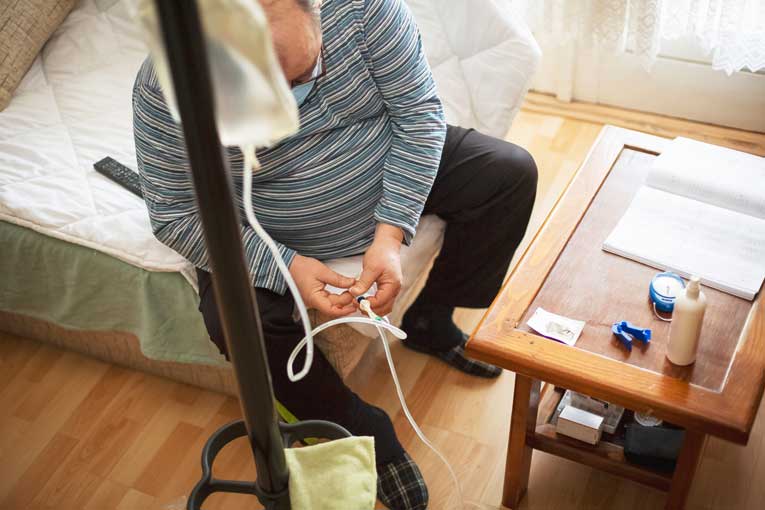- Phone: +91 90020-32757
- info@nefronkidneycare.com
- Mon-Fri (10am - 6pm)


Peritoneal Dialysis
Peritoneal dialysis is a type of dialysis used to treat kidney failure. It is a process of filtering toxins from the blood using the lining of the peritoneum, the thin membrane that lines the abdominal cavity, as the filter. It is a form of renal replacement therapy (RRT) that can be used in place of Hemodialysis.
Peritoneal dialysis works by using a solution that is infused into the abdominal cavity through a catheter. This solution helps to draw toxins and excess fluid from the body. The solution is then drained out of the body and the toxins are filtered away. This process is repeated several times throughout the day.
Types of Dialysis
- 1.Peritoneal dialysis: Peritoneal dialysis (PD) is a type of dialysis that uses the peritoneal membrane in the abdominal area as a filter to clean the blood. This membrane acts as a natural filter, trapping waste products and excess fluid from the bloodstream and passing it into the dialysis solution. The solution is then drained from the body and replaced with a fresh batch of solution. Peritoneal dialysis (PD) is a treatment for kidney failure that uses the lining of the abdominal cavity, or peritoneum, and a cleansing solution called dialysate to remove wastes and excess fluids from the body. During PD, the dialysate absorbs toxins, electrolytes, and fluid from the bloodstream, which are then removed from the body when the dialysate is drained and replaced.
- 2.Hemodialysis: Hemodialysis is a medical procedure used to remove excess fluids and toxins from the body when the kidneys are unable to perform these functions. It involves a process of pumping a patient's blood through an artificial kidney machine, known as a dialyzer, then returning the blood back to the patient's body. During the process, the dialyzer filters out waste products and extra fluids from the blood, then the clean blood is returned to the body. Hemodialysis is typically used for individuals with severe kidney failure or other conditions that cause the kidneys to not function properly.
The major differences between Peritoneal Dialysis and Hemodialysis:
Peritoneal Dialysis:
- 1. Peritoneal dialysis is a type of dialysis that uses the patient’s own peritoneal membrane, or lining of the abdominal cavity, to filter the blood.
- 2. It involves the insertion of a catheter through the abdominal wall, which is connected to a dialysis machine outside the body.
- 3. The dialysis solution, or dialysate, is run through the catheter and into the abdominal cavity, where it absorbs waste and excess fluid from the blood.
- 4. The dialysate is then drained, and the process is repeated several times throughout the day.
Hemodialysis:
- 1. Hemodialysis is a type of dialysis that uses an artificial membrane, or dialyzer, to filter the blood.
- 2. It involves the insertion of a tube, or catheter, into a large vein in the arm or leg.
- 3. The blood is then pumped from the body through the dialyzer, where it is filtered and returned to the body.
- 4. Hemodialysis is typically done three times a week for several hours at a time.
Understanding the Peritoneal Dialysis process

The advantages of peritoneal dialysis include a greater sense of independence and control over care, as well as the flexibility to perform the dialysis treatments at home. It also allows patients to be more active and engaged in their own care. Additionally, it can be less expensive than hemodialysis and require fewer hospital visits.
The disadvantages of peritoneal dialysis include the need for a surgical procedure to place the catheter, the need for large amounts of dialysis solution, and the risk of infection. Additionally, it can be time consuming and can limit the patient's diet and fluid intake.
Overall, peritoneal dialysis is a safe and effective way to treat kidney failure. It is important to discuss the risks and benefits of this form of dialysis with your doctor to determine if it is the best option for you.
When is Peritoneal Dialysis needed?
Peritoneal dialysis is needed when a person’s kidneys are no longer able to adequately filter waste and excess fluids from the body. It is usually used as a long-term treatment for end-stage kidney disease, when the kidneys have lost most of their ability to function.
How long does Peritoneal Dialysis last?
How long does Peritoneal Dialysis last? Peritoneal dialysis typically lasts for 4 to 6 hours. It is typically done 1 to 7 times a week, depending on the individual's specific needs.
During PD, a catheter is placed into the abdominal cavity, and a dialysis fluid solution containing electrolytes and nutrients is infused into the cavity. The fluid circulates in the peritoneal cavity, removing wastes, excess fluid and toxins from the bloodstream.
This is then drained from the abdominal cavity and replaced with a new batch of dialysis fluid. The procedure is typically done for several hours a day, usually 4-5 times per week. It is usually done at home and does not require a hospital stay. PD can provide a high level of kidney function as well as improved quality of life for patients.
Does Peritoneal Dialysis really treat kidneys?
Yes, peritoneal dialysis (PD) is a form of dialysis that uses the lining of the abdomen (the peritoneum) to filter waste products from the blood when the kidneys are no longer able to do so. This type of dialysis can help to manage kidney failure and can help to improve the quality of life for patients with kidney disease.
What are the benefits of Peritoneal Dialysis?
- 1. Greater flexibility: Peritoneal dialysis requires fewer visits to a health care center and allows you to dialyze at home or even while traveling.
- 2. Greater independence: Peritoneal dialysis allows you to manage your own care and dialyze on your own schedule.
- 3. Improved nutrition: Peritoneal dialysis does not restrict dietary intake as much as other forms of dialysis.
- 4. Lower risk of infection: Peritoneal dialysis does not require use of a central venous catheter, which reduces the risk of infection.
- 5. Lower risk of cardiovascular disease: Peritoneal dialysis is associated with a lower risk of cardiovascular disease than other forms of dialysis.
- 6. Improved quality of life: Peritoneal dialysis allows for more flexibility and independence in managing your care, which can lead to an improved quality of life.
How long can a person live on Peritoneal Dialysis?
The average life expectancy of a person on peritoneal dialysis is 5-10 years. However, this can vary depending on the person's overall health, how well they adhere to the treatment plan, and how closely they follow their doctor's instructions.
Which drug is most commonly used during Peritoneal Dialysis?
The most commonly used drug during Peritoneal Dialysis is a dialysate solution, which is a sterile solution of electrolytes and dextrose that is used to fill the peritoneal cavity and facilitate the removal of waste products from the bloodstream.
Can kidneys start working again after dialysis?
Yes, in some cases, kidneys have been known to start working again after dialysis. However, this is not common and depends on the underlying cause of kidney failure. In some cases, dialysis may be necessary for the rest of the patient's life.
Can a person live normal life after dialysis?Yes, a person can often live a normal life after dialysis. It is important to follow the treatment plan recommended by a doctor and maintain a healthy lifestyle with a balanced diet and regular exercise. Many dialysis patients are able to work, attend school, and participate in normal activities.
How painful is dialysis?Dialysis is not usually a painful procedure. Some people may experience some minor discomfort in the area of the body where the needles are inserted. Some people may experience headaches, nausea, muscle cramps, and fatigue after dialysis. It is important to talk to your doctor about any discomfort you may be experiencing.
Can a person do dialysis once a week?Yes, a person can do dialysis once a week if they have been prescribed a modified dialysis schedule by their doctor. This type of schedule is typically used for people with chronic kidney disease who have stable kidney function.
Can you travel if you are on dialysis?Yes, it is possible to travel if you are on dialysis. However, it is important to take extra precautions and plan ahead. You should always talk to your doctor before any travel to ensure it is safe for you. Your doctor may also provide advice on what to do if you experience any complications during travel.
Why choose Nefron for Peritoneal dialysis?At Nefron, we offer a comprehensive range of care, from education to medical procedures, that are tailored to the individual needs of each patient.
We have knowledgeable and experienced healthcare professionals who are certified in this type of care. Nefron also have a team of specialists who can provide comprehensive care, including nutrition and lifestyle counseling, dialysis treatment, and support services. Additionally, being a top Peritoneal dialysis treatment clinic we have an on-site laboratory and the necessary equipment to perform routine dialysis treatments.


